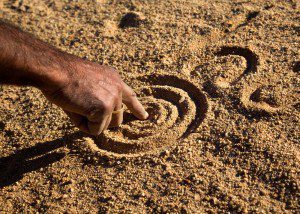By Steven Strong
Contributing Writer for Wake Up World
Before I set foot on Njamal land in the Western Australian Pilbara Region and inspected a very special Original site – the Ganga Maya Cave – I wrote a precursory article which began this series in an admittedly antagonistic vein: see 45,700 Year Old Artefact Overlooked as Mining Approved at Sacred Ganga Maya Cave.
I recently flew to the Pilbara to meet with Njamal Elder Eddy McPhee, and others, to discuss the Maya Ganga mining operation. Eddy and I also inspected the disputed site, and were graciously escorted on site by a representative of Atlas Mining Company.
The way this controversial mining development gained approval suggests a level of disrespect for Original cultural imperatives that stands apart from other mining approvals; this time, that disregard came not just from government or corporate agencies, as we so often expect, but from the archaeologists employed to assess the site’s historical value – and it seems, from within the Original community itself.
[pro_ad_display_adzone id=”110028″]
Eddy describes the superficial archaeology conducted by Big Island Research as an insult to the Njamal people, and says the Yamadtji Marlpa Aboriginal Corporation that supported the Atlas mining proposal does not legitimately represent the true Njamal tribal people.
Home On The Hill
The Maya Ganga Cave (‘Home on the Hill’) is located about 150 kilometres from Port Hedland. On our drive out to the site, the flat apparently featureless plains occasionally gave way to some heavily eroded hills and reminded me of a comment made by the highly respected archaeologist Dianne Bell after spending 18 months with West Australian Original women bound to Old Ways and protocol. On her way in, Bell complained about the constant and somewhat boring uniformity of vegetation and flat geography, and saw little of merit. On her way out, eighteen months later, she saw this area with ‘new eyes’.
Every blade of grass and particle of soil had a tale to tell. She now saw bush tucker, habitats, a huge variation in flora, depressions and water holes, and more importantly, remembered Original stories and teachings associated with the same land that had previously been of no interest to her.
With Njamal Elder Eddy McPhee as my guide and tutor on this trip, that same landscape began to reveal some of these same secrets – some fragile and others much more powerful and extremely ancient.
“Stolen” Lands
As we drove towards the cave, Eddie described what he saw as internal splintering, corruption, ignorance and apathy coming out of both sides of the ‘racial divide’. But one topic dominated proceedings: the parties who have facilitated the destruction of this ancient area are not delineated by colour or race and are both Original and non-Original. Eddy says that over the last 25 years, the Njamal tribal boundaries recognized by government regulators had shrunk by a factor of ten, from a little over 40,000 square kilometers to just on 4,000 square kilometers. He says this was all done “legally”, simply because two families of Original descent have chosen to support the mining companies and given “consent” on behalf of the Original Njamal tribe for this work to proceed at great personal gain, and without the support of their community.
Eddy says around 90% of the Njamal’s homeland been “stolen” in this way, and it seems the local Original people have all but given up the fight. Very few local Original people are still protesting. Dejected, those who have been shunned, slandered or ignored just can’t see any way of winning. Mining companies and increasingly corrupt planning regulators historically excel in manufacturing ‘divide and conquer’ situations within local communities. And at the end of the day, mining approvals don’t require tribal consensus, only the co-operation of ‘representatives’ of the tribal land owners (or Native Title holders – a topic for another article). All too often, mining companies incentive that co-operation from within tribal groups, typically targeting money-motivated members of the community who don’t necessarily represent their people.
Original Elder Eddie McPhee has been fighting for the Original rights of this land for over 25 years, challenging any Njamal people who value the dollar over their culture. Eddy described what he believes to be the “misappropriation” of hundreds of thousands of dollars, “bribes” offered to him by mining companies to secure his compliance or silence, and an inner clique of two families who control the ‘purse strings’ with sole access to the compensation paid to the Original people for their consent. What I found most startling in this story was that, according to Eddy, even though the representatives of these two controlling families were formally voted out as representatives of the Njamal community, they reportedly refused to accept the results of the ballot and still speak “on behalf” of the Original tribes – and remain in control of the financial benefits of the mining agreement. (We will examine these claims in detail in a future article – Editor)
Many other Njamal people are also outraged. But, as Eddy continued describing the elements involved, it soon became obvious why so many others gave up and walked away; their quest for the preservation of this site seems doomed to fail at the hands of Commonwealth-sanctioned ‘progress’. After all, that has been the way of things since the British invasion of the Original tribal countries. Given that this mining development is creeping closer to the Maya Ganga cave as each day progresses, many of his Original brothers and sisters understandably doubt this situation will end any differently. A sad reality.
“Permission to Enter, Boss?”
As we pulled up at the designated visitors check point, which consisted a very small demountable metal box, there was no-one in attendance. It immediately struck me how tragic this scene was; Eddie was an Original man born on this country, but here he was, knocking on the door of a makeshift shed and seeking “permission” to continue onto his peoples’ tribal land. And this IS his people’s land; no-one on either side of the dispute is denying that fact. But today, until permission is granted through ‘legal’ channels specified by Commonwealth governments, Eddy could only stand on the borders and peer into the distance of his peoples’ tribal home.
To a proud Original man, this is an affront not just to himself but to his heritage, and the ancestral spirits.
Suddenly, the days of “Aboriginal reservations” don’t seem so distant.
With no-one in attendance at the entrance, or in the vicinity, we decided to drive on and see what eventuated. Another 15 minutes down the same dirt road found us at the central point of Atlas Mining Company activities. It was a complex of demountable metal buildings, sheds, metal scaffolding, machinery, and three large cylinders each holding 11,000 litres of diesel. I stayed in the 4wd while Eddy made his way over to the office.
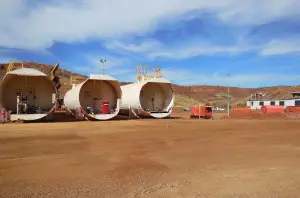 As he disappeared inside the administration complex, it struck me that nothing here seemed permanent. Every building and container could be picked up and moved elsewhere within a moment’s notice. As it turns out, Atlas Mining Company has been granted a temporary 5 year lease on this site, the result being that they will strip this site bare before 2019 and move on to another site to repeat the same process.
As he disappeared inside the administration complex, it struck me that nothing here seemed permanent. Every building and container could be picked up and moved elsewhere within a moment’s notice. As it turns out, Atlas Mining Company has been granted a temporary 5 year lease on this site, the result being that they will strip this site bare before 2019 and move on to another site to repeat the same process.
So in essence, the dispute over this site comes down to… 45,000 years of ancient Original history? or 5 years of iron ore mining?
A Gesture of Goodwill?
The longer I waited for Eddy to reappear, the more convinced I became that our permission to inspect the site had been denied. But after some discussion with those in control, we were given consent to enter, inspect, and surprisingly, take photographs. But before we started, we were expected to abide by the company rules and were subsequently searched for the presence of alcohol, given a vest, hard hat and briefed on safety procedures. Is this really the sort of experience an Original Elder should be subjected to, just to access his tribal lands?
An Atlas Mining Company representative, Kyle, escorted us into the cave. He was quite pleasant, seemed genuinely sympathetic, knew quite a bit about the cave, and was more than willing to assist our enquiries. As we walked towards the door leading towards the exit, Kyle pointed out an enlarged copy of the the pamphlet that was released to the public, detailing the archaeological assessment that was carried out prior to the mine’s approval. Kyle pointed out one photograph in the bottom corner, and stated that this photo was not taken in the Maya Ganga Cave but was taken in another cave, the location of which he was unaware. He was also unaware of the findings of the other cave’s examination.
The alarm bells began to ring in my head. While the opening to the archaeological report mentions that three other caves were examined – Chalka Burda, Mardu Maya and Bilyardi caves – the entire document focusses solely on findings at the Maya Ganga Cave. Kyle’s description of another cave worthy of photographic publication was of great concern, and gave me even more reason to question the expertise of the archaeology conducted and quality of the ‘findings’ reported.
What was found in the other three caves? Why has further archaeology not been completed, as the initial report suggested? Why is this mining operation still permitted to continue in an area recently proven to have housed the world’s longest known (and still unexplored) human occupation?
Those questions were eclipsed in my mind by the Atlas rep’s following comment; that further archaeology was to be completed by a team comprised mainly of first year archaeology students! The notion of novices with virtually no expertise or experience being summoned into the field for such an important investigation was disconcerting, as is the potential that they are to be supervised by the same academics who produced the first underwhelming (and inaccurate) assessment of the site.
But the story got much worse once another piece of information was volunteered, notably, without a trace of alarm or dismay.
Blow It Up!
Not only is low grade iron ore already being mined within 300 metres of the Maya Ganga Cave, the Atlas representative Kyle says the mining operation will get much closer to the cave in the months to come. He elaborated, and described the company’s intention to call in a Geophysicist to assess the feasibility of blasting and mining directly behind and beside this ancient cave.
I couldn’t believe what I was hearing! It is already unforgivable that mining activity is being undertaken within 300 metres of an ancient site that has already revealed artefacts that blow existing accounts of human history out of the water. It is already unconscionable that only 2% (if that) of the Maya Ganga Cave was properly investigated, with no further examination completed in the broader area, despite these findings. Now, the cave itself is in the direct line of fire.
Compounding this outrage, the Atlas representative spent some time pointing out the instability of the rock stratums inside the cave. There were rocks, some of considerable weight, strewn all over the cave floor, and every time I looked up was a disconcerting experience as many rocks seemed to be precariously balanced and ready to fall. My only hope was that they would remain in place until after I left the cave! Any moderate disturbance in this area would shake this cave into a pile of rubble. There is absolutely no need for any paid geophysicist to inspect it; five seconds inside the cave and a modicum of commonsense are sufficient to determine that one blast will bring this tenuous structure to the ground.
Adding insult to injury, Kyle also explained that the iron ore being extracted by Atlas Mining Company is a common low grade ore (52-54%). It is bad enough that the immediate surrounds of this ancient site are to be mined, but even worse knowing the excavation of an ordinary low-quality mineral has been given precedence over the ancient human history evident at this site.
Iron-rich rocks are common worldwide, and it is not particularly hard to geologically prove enough tonnage of the rocks exist at a site for a mining operation to be profitable. But despite its prevalence, mining iron ore is a high volume low margin business. As iron ore attracts a low market price, the location of mining sites is largely determined by the pre-existence of commercial port and rail infrastructure. Due to such economic rationalizations, the mining industry doesn’t seek sites that create minimal impact to the environment or to Original tribes, rather they simply seek low cost sites near existing infrastructure, leading to the centralization of mining operations in areas that cannot or should not sustain them.
Not surprisingly, our economically-focussed government doesn’t just support such short-term thinking, it subsidizes it.
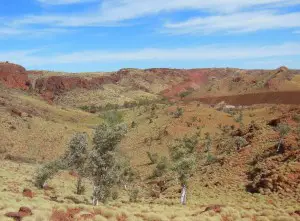 Geoscience Australia calculates that the country’s “economic demonstrated resources” of iron currently amount to 24 gigatonnes, or 24 billion tonnes. The current production rate from the Pilbara region of Western Australia is approximately 430 million tonnes a year and rising. Experts Dr Gavin Mudd (Monash University) and Jonathon Law (CSIRO) expect deposits of iron to be gone from the area within 30 to 50 years (Mudd) and 56 years (Law). (For more information, please read the ABC News article Iron ore country: scientists predict we may run out of high quality exportable iron ore within 50 years).
Geoscience Australia calculates that the country’s “economic demonstrated resources” of iron currently amount to 24 gigatonnes, or 24 billion tonnes. The current production rate from the Pilbara region of Western Australia is approximately 430 million tonnes a year and rising. Experts Dr Gavin Mudd (Monash University) and Jonathon Law (CSIRO) expect deposits of iron to be gone from the area within 30 to 50 years (Mudd) and 56 years (Law). (For more information, please read the ABC News article Iron ore country: scientists predict we may run out of high quality exportable iron ore within 50 years).
According to the Atlas Mining Company representative, after 5 years on this site, this deposit will be exhausted and the operation will move to another location already ‘ear-marked’ for quarrying. In essence, at least 45,700 years of human history will be destroyed in favour of 5 years worth of unsustainable economic growth.
Continuous Occupation
The site felt so old, and although empirically unmeasurable, the ancient Original guardian spirits were clearly present. But only a few hundred metres away, the earth was being exposed and loaded into trucks for commercial export. The only iron clad guarantee the Atlas Mining representative could offer was that the trucks would get much closer.
Despite the existing damage and the promise of more to come, there are hundreds of other caves and sites of Original significance in the general area. According to locals, many are unreported in official government records, enabling them to be destroyed by mining companies without consultation. In fairness, the mid tier mining company appears to have done more to assess this site than many other larger companies bother with, and should be recognized for that gesture – even if result has been found to be sadly lacking.
However, that commendation comes with an equivocation. Because of the admitted incompleteness of the initial archaeological assessment, why did the Atlas Mining executive decide to continue its operation, knowing what was found in the area? Even the pamphlet released to the public referred to evidence of ancient occupation, it doesn’t take an archaeologist to realize (and they didn’t) — where there is one ancient site there will be many.
If an amazing new discovery was found in Egypt that pushes back the timing as to when ancient Dynasties first came to power, any threat to the site’s integrity would be immediately halted and experts from all over Egypt would flock to that site. Only the most learned scholars would be involved in an official assessment. An expert in Egyptian archaeology would oversee every sod of soil upturned and artefact found. And no doubt, the Supreme Council of Antiquities (the Egyptian equivalent of the Department of Heritage) would be informed of such developments.
In the case of Maya Ganga Cave, the archaeologists reported that “Maya Ganga may be only the fourth known site with evidence of occupation during the last glacial maximum (ice age)… Maya Ganga is certainly one of the oldest dated archaeological sites in the Pilbara”. But this information has seemingly been disregarded by stakeholders at all levels, and I can find no record that this information was provided by the research team to the Western Australian State Heritage Office – as one would expect.
Original Knowledge and Protocols
I spent some time examining and assessing the alignments formed by two rocks the Atlas representative claimed (and I agree) were exotic and thus brought to the cave by Original people. Not only were both unnaturally shaped but neither displayed any evidence of the typical percussion points evident of Original rock-on-rock technology. Such unnatural features are not uncommon to my team and I; we have seen many rocks on the east coast of Australia that have been shaped in a similar fashion, which at very least requires a metal blade. And the two rocks identified at this site also fit that pattern, and were clearly shaped using more advanced tools than are typically attributed by white-fellas to the technology of the ancient Original peoples.
As I had learned from Ramindjeri Elder Karno Walker, such stone arrangements are generally positioned in threes – three being a number sacred in Original culture. So, armed with Original knowledge that was evidently not bestowed on the archaeologists who first assessed the cave, or their Original guides, I began looking for the third shaped rock. It took less than a minute before I found it, after clearing away some loose soil and a few strands of spinifex.
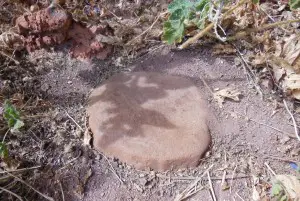 As I stated earlier, a team of archaeologists spent many hours in research of this site, but did not manage to find much less interpret – in context – objects that are obviously not part of the local geology. I believe this simple discovery suggests an inadequate understanding of Original archaeology, not only within the Big Island team but also the Yamadtji Marlpa Aboriginal Corporation, who controversially claimed to represent the Original people in this excavation.
As I stated earlier, a team of archaeologists spent many hours in research of this site, but did not manage to find much less interpret – in context – objects that are obviously not part of the local geology. I believe this simple discovery suggests an inadequate understanding of Original archaeology, not only within the Big Island team but also the Yamadtji Marlpa Aboriginal Corporation, who controversially claimed to represent the Original people in this excavation.
Compounding the problem was another fundamental error. The Maya Ganga Cave is a sacred men’s site. According to Original lore, only women of the very highest degree can enter such a sacred men’s site. But Original lore was not respected in this case. The women brought on site by Big Island Research during the archaeological examination have no such Original pedigree and, out of respect for Original lore and protocols, should never have been permitted to set foot in or near this cave. But again, without any understanding of the cultural context in which they were working, they committed further cultural affront to the Original tribal people. Notably, representatives of the Yamatdji Marlta Aboriginal Corporation didn’t seem to mind.
An examination of the Big Island Research team poses further questions. According to Big Island Research, Big Island’s Managing Director Guy WrightPhD is a “former Senior Anthropologist with the National Native Title (1994-06)” and a “Senior Assessment Officer with the Department of Aboriginal Sites from 1992-1994”. Other members of the team, including those who attended the site, describe backgrounds in “working with local Aboriginal (sic) people”, playing “a key role in writing heritage reports” and “a wide range of experience in historical and Indigenous archaeology”.
So, if these credentials hold true, why were 5 women from Big Island Research sent to this site? Why were basic understandings of Original culture and archaeology not applied?
Why were relevant government authorities not engaged with their findings?
And why would professional archaeologists recognize a site’s “potential to make a significant contributing to our understanding of the early human occupation” and acknowledge that it may reveal “how people lived as climate changed during the first glacial period”…. and then leave after two days with only a fragment of the story? Where is the spirit of genuine scientific enquiry? Did they even understand how important this discovery actually is to our understanding of humanity’s origins?
In my opinion, the apparent failings of this 2-day excavation raises questions not just of the expertise and engagement of the archaeologists involved, but also the knowledge (and therefore the connection to culture) of those ‘Traditional Owners’ who guided this exploration. Without the requisite cultural understanding (and I’m just scratching the surface here) or adequate time spent on site, too many mistakes were made. Given the obvious shortcomings of the work conducted, the management at the archaeology company should never have facilitated this mining approval by agreeing to put their name to such inadequate and culturally inept work.
Shooting the Messenger?
Since my earlier article on this topic, I have been criticised for being so strident in taking to task the archaeologists employed, rather than the Atlas Mining Company. From my contact with Atlas, I suspect that this relatively small mining company does have a community conscience. Beside significant investment in the local communities, they initiated and paid for archaeologists to assess the site, and then encouraged the publication of their unexpectedly ancient findings. It is true Atlas has shown little appreciation for the nuances and implications of these findings, and that is regrettable, but I believe it is understandable.
What else does one expect of a mining company? While Atlas Mining showed little contextual appreciation for their findings, they employed an archaeology firm with stated experience in ‘Aboriginal’ archaeology. From the facts at hand, the team they employed did not measure up to the task. Which is more damnable?
Professional archaeologists were briefed to inspect and report back their findings, but were found manifestly lacking in their knowledge of Original archaeology – a prerequisite for exploring the site in proper context. And their Original companions showed no appreciation of the sacredness or significance of this site, themselves disregarding protocol and lore by accompanying women to a sacred men’s site. The archaeologists on site had a duty of care, and they failed. Equally, it is obvious they have no grasp of the interconnected nature of this site to others nearby – and indeed across the continent. The pamphlet they produced makes no mention of the sacredness of the cave or the region it occupies, no mention that the date of 45,700 years could make this the oldest known site in Australia, or that there are sacred Dreaming tracks radiating outwards from the cave to other sites of high Original significance.
Context is everything in ancient indigenous archaeology. From an archaeological perspective, this is inexcusable.
From the reports available, Big Island also made no recommendations to government regarding this ancient site, and no guidance as to what work should be undertaken next; a key requirement of any archaeological assessment, particularly one that is conceded to be so incomplete due to time constraints – and so very important. Regardless of whether further work had already been commissioned, to simply assert that “further excavation” is required contributes nothing.
Notably, fourteen months later, “further excavation” is still required.
Out of Africa? Out of its Depth.
If more homework had been done by the Big Island archaeologists, before or after coming onto this site, they may have begun to appreciate that the estimated date of 45,000 years undermines the foundation of every commonly accepted theory of our ancient non-Original ancestry. The previously accepted maximum date for human occupation of the Pilbara region was 25,000 years.
One of the most respected Australian proponents of the Out-of-Africa theory, Jim Bowler supposed a gradual spread of Africans around the coastal fringe, with the Pilbara the being last stop before the continent was fully occupied. When assessing Alan Thorne’s re-dating of the Mungo Man (WL3) specimen to 63,000 years, he conceded a more convenient Out-of-Africa friendly date of 45,000 years, but argued that the this timing “does not disagree with my original and fundamental premise that Australia was colonised by coastally adapted people whose colonising routes were around the coast and up the major river systems”. But an estimated 45,000+ years of continued occupation of the Pilbara region certainly puts rest to this concept; for it to be true, Africans must have chosen the remote inland Pilbara as their first stop-over.
Respected archaeologist Josephine Flood stated that the Pilbara “would have lain 500 kilometres inland and been even drier at the height of the last glacial period”, when humans first stood inside the Home on the Hill. So adverse were the climatic conditions estimated to be at the time, it was believed (until this cave was investigated) that “there is currently no empirical evidence for continuity of occupation during the height of the last glacial maximum”. But physical evidence found by the Big Island researchers at Maya Ganga Cave suggests the area was occupied continuously from 47,000 years to 1,000 years ago. And being situated nowhere near any major river system, past or present, it immediately negates the commonly accepted myth that Australia was first occupied on the east coast by sea-fairing African coast huggers. Quite simply, such a scenario doesn’t make sense.
Mainstream archaeology is out of its depth here.
Cross Roads
Undeniably the mining operation outside the Maya Ganga Cave will continue to create great distress for the Original people of the Pilbara. But what else could we expect?
In fairness, the mining company appears to have made a fair attempt to do the right thing, when many others would do nothing. The depth of information and context available to decision makers fell well short due to the apparent shortcomings of the Original representatives and the archaeologists commissioned to do the work. The published assessment of the site supplies no Original context, and the only Original people consulted oversaw a breach of Original protocol — and have reportedly been denounced by the wider Njamal tribal community. So how could Atlas make an informed decision?
Despite all the damage and grief, all is not lost.
If Atlas Mining Company Managing Director Ken Brinsden and his team were to engage in meaningful dialogue with Eddy McPhee and the many other concerned community members and tribal Elders, a conciliatory path forward still exists. It is not too late. The Nyamal tribal people want to be heard, and a genuine exchange of Original culture and lore is still possible. The tribal Elders of the area are literally begging for an audience to listen to them, and are more than willing to engage in constructive discussions with company representatives.
There are two choices on the table: either to talk and listen in good faith, or carry on as if none of this matters in the slightest.
The truth is, it DOES matter. This site is significant not just to the Original people of the Pilbara but to the scientific community on the whole. Beside providing the “potential to make a significant contributing to our understanding of the early human occupation of Australia”, the protection and further examination of this site may also reveal “how people lived as climate changed during the first glacial period”; an invaluable insight.
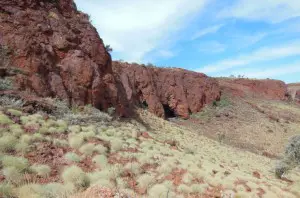 If the Atlas Mining Company continues down this path and mines beside and behind what could be the oldest occupied site in Australia’s history, their profits will marginally increase – but at what cost? Is the preservation of one of the oldest (if not the oldest) occupied sites in Australia is a comparable priority to the extraction of low grade iron ore for a few years of economic profit? If learning from 45,000 years of history means less than short term gain, then we as a nation reveal ourselves to be unprincipled bandits who will let nothing get in the way of a profit.
If the Atlas Mining Company continues down this path and mines beside and behind what could be the oldest occupied site in Australia’s history, their profits will marginally increase – but at what cost? Is the preservation of one of the oldest (if not the oldest) occupied sites in Australia is a comparable priority to the extraction of low grade iron ore for a few years of economic profit? If learning from 45,000 years of history means less than short term gain, then we as a nation reveal ourselves to be unprincipled bandits who will let nothing get in the way of a profit.
Australia – and particularly the Australian mining industry – is at a crossroads. Atlas is a mid-tier mining company with a reasonable reputation. If they do the right thing here they will stand above every mining company in the land and set a valuable precedent and admirable standard of practice that will resonate throughout the country. At this moment, Atlas can choose to lead by example, prioritizing ancient cultural imperatives over short term economic ones. They can choose grace and respect, or money.
Over to you Atlas, it is your call. We dearly hope and pray you have a conscience.
Let Atlas Know Your Thoughts
Let the Atlas Mining Company know what you think about the mining development at the ancient Maya Ganga Cave.
Email: [email protected]
Phone: +618 6228 8000
We are asking Atlas to make a respectful and reasonable decision in relation to this site. In that spirit, please be equally respectful in your dealings with their company representatives.
About the author:
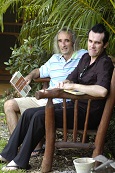 Steven Strong is an Australian-based researcher, author and former high school teacher. Together with his son Evan, his work is to explore the ancient story of the Original people, a narrative that was almost lost to aggressive European colonisation.
Steven Strong is an Australian-based researcher, author and former high school teacher. Together with his son Evan, his work is to explore the ancient story of the Original people, a narrative that was almost lost to aggressive European colonisation.
Edited and additional commentary by Andy Whiteley for Wake Up World.
This article © Wake Up World.
[pro_ad_display_adzone id=”110027″]

